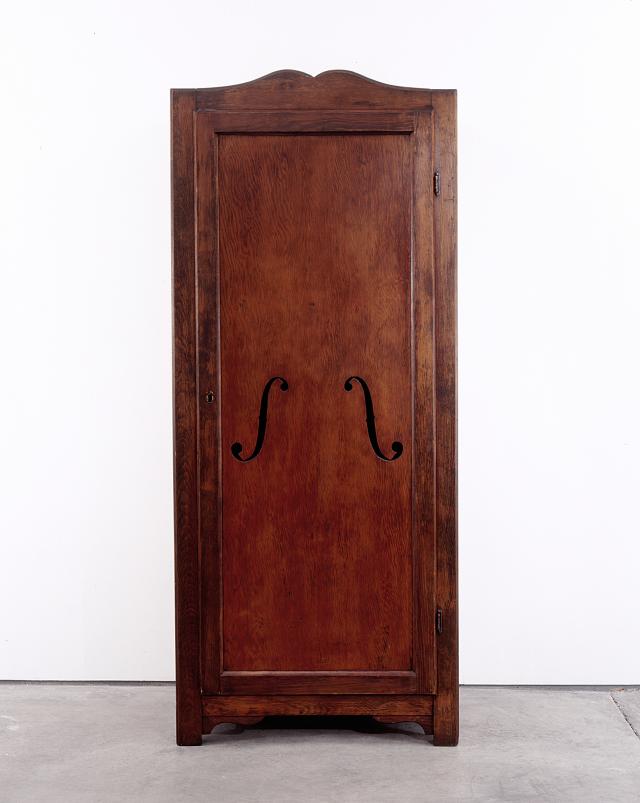Christian Marclay’s Armoire perfectly fits within the artistic approach of this sound creator who tirelessly explores in his practice the connections between the visual and the audible. From more than thirty years, he has created works in which these two distinct sensorial experiences are enriched and defy each other mutually. A rare sculpture within his productions, this object is nothing other than a wardrobe in stained wood, probably unearthed at a market or a garage sale, if we take into account the natural penchant of the artist to recycle old objects.
Both a collector and a composer, Marclay has always enjoyed integrating his finds – be they material or technical – into his creative process. He appropriates them to breathe new life into them. This item of domestic furniture, at first sight banal, thus hosts a singular addition, namely two large openings in the form of sound holes, carefully cut out by the artist in the door panel. Their presence, along with the very material of the object, reminds us, with no room for doubt whatsoever, of a string instrument and, by extension, its many visual representations.
Multiplying references, as usual, Marclay openly alludes to the famous photograph of Kiki de Montparnasse, between woman and cello, seen from the back, by Man Ray (Le Violon d’Ingres, 1924), itself inspired by the Orientalist painting Le Bain turc (1863) by Jean Auguste Dominique Ingres. Unlike the installation Étant donnés (1946-1966) by Marcel Duchamp and its voyeuristic component, there is nothing to see behind these openings which convoke a sound rather than a visual obsession.
Nevertheless, lacking strings, the instrument created by Marclay cannot be played. Assimilated to a simple sound box, it induces us to imagine, beyond the perceptible silence, a large palette of possible sounds for whoever opens their ears and knows how to listen. In an even more discreet way than in his numerous mute onomatapoeia, here the artist manages, by the simple power of a familiar visual motif, to make the absence of sound – a key subject of his oeuvre – tangible.
Both a collector and a composer, Marclay has always enjoyed integrating his finds – be they material or technical – into his creative process. He appropriates them to breathe new life into them. This item of domestic furniture, at first sight banal, thus hosts a singular addition, namely two large openings in the form of sound holes, carefully cut out by the artist in the door panel. Their presence, along with the very material of the object, reminds us, with no room for doubt whatsoever, of a string instrument and, by extension, its many visual representations.
Multiplying references, as usual, Marclay openly alludes to the famous photograph of Kiki de Montparnasse, between woman and cello, seen from the back, by Man Ray (Le Violon d’Ingres, 1924), itself inspired by the Orientalist painting Le Bain turc (1863) by Jean Auguste Dominique Ingres. Unlike the installation Étant donnés (1946-1966) by Marcel Duchamp and its voyeuristic component, there is nothing to see behind these openings which convoke a sound rather than a visual obsession.
Nevertheless, lacking strings, the instrument created by Marclay cannot be played. Assimilated to a simple sound box, it induces us to imagine, beyond the perceptible silence, a large palette of possible sounds for whoever opens their ears and knows how to listen. In an even more discreet way than in his numerous mute onomatapoeia, here the artist manages, by the simple power of a familiar visual motif, to make the absence of sound – a key subject of his oeuvre – tangible.
